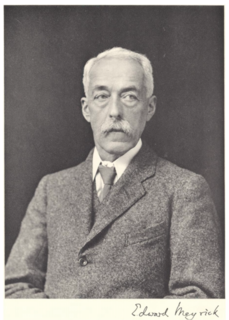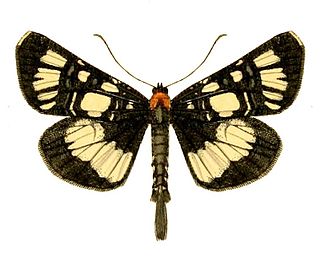
Edward Meyrick was an English schoolmaster and amateur entomologist. He was an expert on microlepidoptera and some consider him one of the founders of modern microlepidoptera systematics.
Heterobathmia is a genus of Lepidoptera. It is the only genus in the suborder Heterobathmiina, as well as in the superfamily Heterobathmioidea and in the family Heterobathmiidae. Primitive, day-flying, metallic moths confined to southern South America, the adults eat the pollen of Nothofagus or southern beech and the larvae mine the leaves. Most known species are undescribed.
Sir George Francis Hampson, 10th Baronet was an English entomologist.

Eupterotidae is a family of insects in the order Lepidoptera with more than 300 described species.

Urodidae or "false burnet moths" is a family of moths in the lepidopteran order. It is the type genus in the superfamily, Urodoidea, with three genera, one of which, Wockia, occurs in Europe.
Agathiphaga is a genus of moths, known as kauri moths. It is the only living in the family Agathiphagidae. This caddisfly-like lineage of primitive moths was first reported by Lionel Jack Dumbleton in 1952, as a new genus of Micropterigidae.

Sematurinae is a subfamily of moths in the family Sematuridae represented by at least 29 species in the Neotropics.
Himantopterus is a genus of moths in the family Himantopteridae. It was described by Constantin Wesmael in 1836.

George Talbot FES was an English entomologist who specialised in butterflies. He wrote about 150 scientific papers, the majority being primarily systematic, consisting of the description of new species or the revision of various genera. He was also responsible for the curation and preservation of the Joicey collection of Lepidoptera prior to its accession by the Natural History Museum.

The Thyatirinae, or false owlet moths, are a subfamily of the moth family Drepanidae with about 200 species described. Until recently, most classifications treated this group as a separate family called Thyatiridae.

Hespagarista is a genus of moths of the family Noctuidae. The genus was erected by Francis Walker in 1854.
Celonoptera is a monotypic moth genus in the family Geometridae. Its only species, Celonoptera mirificaria, is found in south-eastern Europe. Both the genus and species were first described by Julius Lederer in 1862.
Victor Gurney Logan Van Someren was a zoologist and entomologist.
Hypercompe caudata is a moth of the family Erebidae. It was described by Francis Walker in 1855. It is found in Texas, southern Arizona, Mexico, Costa Rica, Honduras and Nicaragua.
Labdia caudata is a moth in the family Cosmopterigidae. It is found in Sri Lanka.
Orientozeuzera is a genus of moths in the family Cossidae.
Orientozeuzera caudata is a moth in the family Cossidae. It was described by James John Joicey and George Talbot in 1916. It is found in New Guinea. There are also records for Japan, Malaysia, Indonesia and the Solomon Islands, but these refer to Orientozeuzera rhabdota. The habitat consists of lowland areas.
Himantopterus caudata is a moth in the family Himantopteridae. It was described by Frederic Moore in 1879. It is found in Myanmar and Assam, India.






